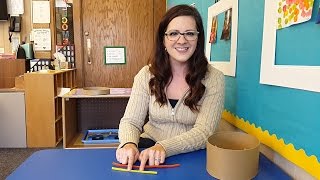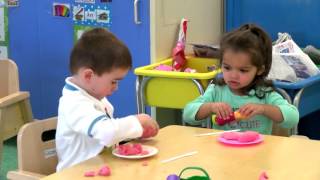This video describes children’s ability to notice the various attributes of objects and to describe their sizes. Adults can introduce measurement of those objects using both standard and nonstandard units. This video is part of a series describing children’s early mathematical development and showing how professionals can support this development during play, in daily routines, and through explicit teaching.
See supporting materials and related videos at http://www.easternct.edu/cece/elds-math-measurement/.
Copyright 2016 by the Connecticut Office of Early Childhood. Produced by the Center for Early Childhood Education at Eastern Connecticut State University. This video may only be used for educational purposes.
Read Transcript
Dr. Sudha Swaminathan: “Objects have different attributes. They have length; they have a size; they have a capacity and weight. The easiest for children to understand initially is length of height or width. And the reason being, that they can immediately see it. So, young children, when they’re beginning to use measurement, you see them initially a lot of direct comparisons.” Teacher: “It’s almost getting as tall as Pablo, isn’t it?” Child: “I’m taller.” Teacher: “You are taller.” Sudha Swaminathan: “So, they make these comparisons between themselves and the blocks or between two things. Gradually they start to use a measuring tape or something else. Teacher and child: “Seven, eight, nine, ten. Ten inches!” Narrator: “While linear measurement is the most concrete for children to comprehend, adults can help them explore other attributes as well.” Sudha Swaminathan: “We want to engage children in lots of ways that they can measure. For instance, to have containers, where they can measure out unit by unit into a larger container. To maybe engage in counting how many times to fill a certain container. Teacher: “Two. Look! It took two scoops to fill it up.” Sudha Swaminathan: “Those experiences invite children to look at capacity and to start to think about it.” Boy: “Jackie, mine is getting bigger.” Girl: “Mine, this one is getting bigger.” Sudha Swaminathan: “Young children can compare the measurable attributes of weight. They may not be able to measure and tell you how much it weighs, or how much it holds, but they can compare it. They can feel that one object is heavier and another.” Child: “Heavy.” Provider: “What do you think of that one?” Child: “It’s light.” Sudha Swaminathan: “To engage children in measurement exercises, we want to have lots of measuring tools in the classroom. We should definitely have rulers and measuring tape, some scales, but we should also recognize that children may not immediately understand these tools.” Claudia Ahern: “They get excited when the tape measure gets longer and longer. But for me to say, “It’s thirty-six inches,” that is not something that someone who’s three can comprehend.” Child: “It’s ten feet high, Claudia!” Sudha Swaminathan: “When you use nonstandard units, such as Unifix cubes, to measure something, children gradually put one Unifix cube to another, and they are building up the nonstandard unit, and that helps them realize that each object is actually counting gradually, the while length of their object. And that experience enables them to actually measure the object in more realistic and authentic ways.” Narrator: “Adults can provide opportunities for children to notice the attributes of objects and explore various ways of measuring them.” Teacher: “Is the length bigger or the width? Which is bigger?” Child: “The down.” Narrator: “Through planned activities, children can be supported to explore both standard and nonstandard measurement.” Teacher: “So, this ruler id two worms. Equal to two worms.” Child: “Equal two worms, two worms.” Teacher: “Should we measure the Magna-Tiles?” Narrator: “When opportunities arise, adults can support children to problem solve and use measurement as a tool.” Teacher: “Will it fit? How do we find out if it fits?” Child one: “We have to try it.” Child two: “We have to measure it.” Teacher: “It’s up to eleven, and many was the light box, how many inches?” Child: “Ten.” Teacher: “Ten. So, which one’s bigger?” Narrator: “During play, adults can help children notice the attributes of their toys.” Teacher: “Do you want big, little, or medium? Medium, where’s the medium? Nice job.” Sudha Swaminathan: “Measurement is most meaningful for young children when they have to use it to solve a problem in their day-to-day routines or their activities in the classroom.






